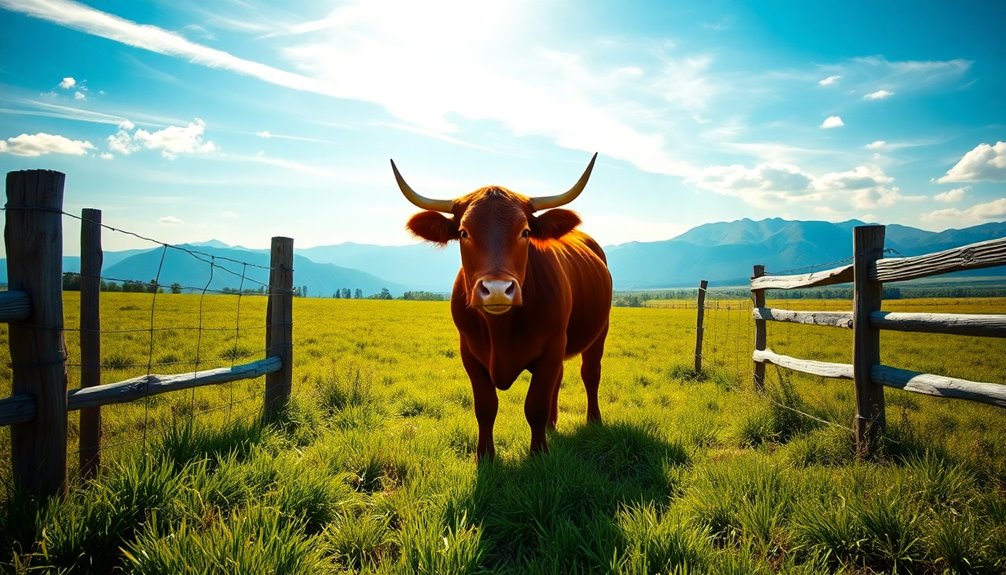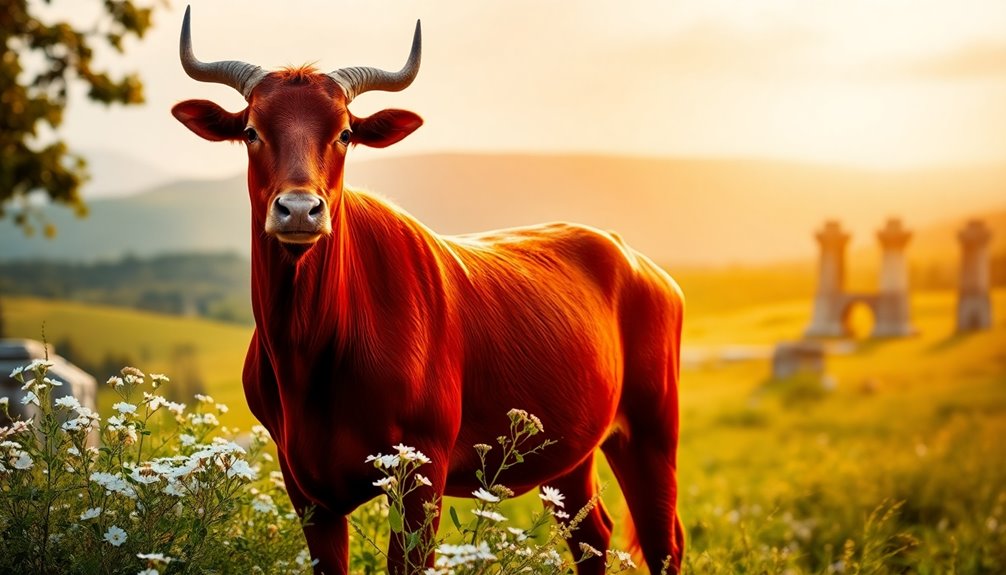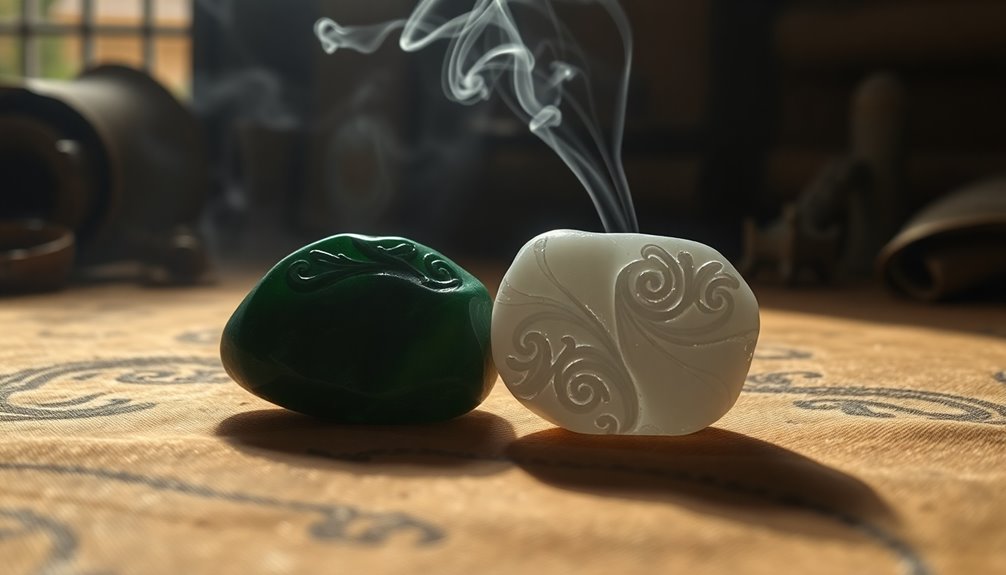The red heifer prophecy is crucial in Jewish beliefs, symbolizing the future arrival of the Messiah and the rebuilding of the Third Temple. According to biblical texts, particularly Numbers 19, the ashes of a blemish-free red heifer are essential for purification rituals. These rituals cleanse those who are impure, especially after contact with death, allowing them to participate in Temple worship. Historically, only nine red heifers have been sacrificed, heightening anticipation for the tenth, which was born in Israel in 2018. This discovery has sparked renewed interest in its implications for the future. Discover what this means for today's faith.
Key Takeaways
- The red heifer prophecy is crucial in Jewish eschatology, linked to the arrival of the Messiah and the rebuilding of the Third Temple.
- Only nine red heifers have been sacrificed since Moses, with the expectation of a tenth heifer, which is seen as a prophetic sign.
- The ashes of the red heifer are essential for ritual purification, enabling individuals to become eligible for Temple worship.
- A blemish-free red heifer discovered in 2018 has reignited interest and hope among believers regarding the fulfillment of this prophecy.
- The red heifer ritual symbolizes purification and atonement, holding significant theological implications in both Jewish and Christian traditions.
Introduction

The red heifer prophecy holds significant importance in Jewish eschatology, particularly due to its foundations in biblical texts like Numbers 19. This prophecy centers around the red heifer, a rare animal whose ashes are essential for the purification process outlined in Jewish law.
These ashes are crucial for the ceremonial cleansing of individuals who've come into contact with death, which is necessary for the resumption of Temple services.
Historically, only nine red heifers have been sacrificed from the time of Moses until the destruction of the Second Temple. The expectation of a tenth red heifer, provided by the Messiah, marks a pivotal eschatological event for Jews, signaling the approach of the Messianic Era.
In recent years, the discovery of a blemish-free red heifer in Israel has sparked renewed interest and speculation about the imminent rebuilding of the Third Temple in Jerusalem.
Organizations like the Temple Institute actively pursue the breeding of a red heifer, viewing its emergence as a critical sign for the prophetic restoration of the Jewish Temple.
This belief underscores the red heifer's role in fulfilling ancient prophecies and the anticipation surrounding future events in Jewish tradition.
Biblical Significance of Purity

When you explore the Biblical significance of purity, you'll notice how the red heifer plays a crucial role in maintaining ritual cleanliness.
Primary and secondary Bible references highlight the importance of these purification practices and their connection to worship.
Understanding these scriptural elements can deepen your appreciation for the standards set forth in the Torah.
Primary Bible References
Purity in biblical texts is exemplified through the ritual of the red heifer, as outlined in Numbers 19:2-10. This ritual is crucial for purification, especially for those who've come into contact with death, marking a significant aspect of Old Testament practices. According to biblical law, the red heifer must be entirely red, with no more than two non-red hairs, symbolizing purity and perfection. The ashes from this sacrificial animal are mixed with water to cleanse individuals and objects, restoring their eligibility for participation in Temple worship.
Rabbinical tradition highlights the rarity of the red heifer, stating there have only been nine since Moses. This emphasizes its importance in Jewish religious practice. The upcoming tenth red heifer, prophesied to be sacrificed, is deeply tied to eschatological beliefs concerning the coming of the Messiah and the rebuilding of the Third Temple.
This connection elevates the red heifer from mere ritual to a pivotal element in prophetic fulfillment. Understanding these primary biblical references sheds light on the profound significance of the red heifer in maintaining purity and its role in the broader narrative of redemption within scripture.
Secondary Bible References
In understanding the biblical significance of purity, one can't overlook the role of the red heifer beyond its initial mention in Numbers 19. The red heifer sacrifice serves a holy purpose of purification, particularly for those rendered ceremonially unclean through contact with death. This ritual is deeply embedded in Jewish oral tradition, emphasizing the need for ritual cleanliness in the Temple service.
The requirement for the heifer to be without defect or blemish, and never yoked, reflects God's high standards for holiness in sacrificial offerings. The ashes of the heifer, mixed with living water, are sprinkled on the third and seventh days of purification, underscoring the meticulous process of purification from sin.
Rabbinical teachings note that only nine red heifers were sacrificed from the time of Moses to the destruction of the Second Temple, highlighting the rarity and significance of this offering.
The red heifer ceremony not only atoned for the sin of the golden calf but also interconnected the themes of purity, repentance, and divine forgiveness. Thus, the red heifer remains a powerful symbol of purification in biblical tradition.
Ancient Purification Rituals

Drawing on ancient traditions, the red heifer ritual stands as a profound example of purification practices in Jewish culture. This ritual, described in Numbers 19, revolves around the sacrifice of a completely red heifer, one that's without blemish and has never been yoked. The ashes of a red heifer are crucial for cleansing individuals from ritual impurity, particularly after contact with the dead.
Historically, only nine red heifers were sacrificed from Moses' time until the destruction of the Second Temple, underscoring the ritual's rarity and significance. The purification process involves mixing these ashes with living water and sprinkling it on those needing cleansing on the third and seventh days post-contact with death.
This meticulous approach to purification is essential for participation in Temple worship, connecting to broader themes of redemption and eschatology in Jewish thought.
As you delve deeper into the red heifer's role, it becomes clear that this ancient ritual not only serves a practical purpose but also embodies a spiritual journey toward restoration and holiness.
Symbolism of the Heifer

The red heifer embodies profound symbolism within Jewish tradition, particularly regarding purification and atonement. This rare animal, with its requirement of being entirely red and free from blemish, represents a unique connection to the divine. Its ashes, mixed with water, serve as a powerful tool for purification, especially for those who've encountered death.
When you consider the significance of the red heifer, it's striking how its ashes not only cleanse individuals but also sanctify the Temple and its sacred vessels, reinforcing its communal importance.
The red heifer's sacrifice, performed outside the camp, draws parallels to the crucifixion of Jesus, highlighting themes of ultimate sacrifice and redemption. This connection deepens the understanding of atonement within both Jewish and Christian contexts.
Furthermore, Jewish eschatological beliefs link the future appearance of the tenth red heifer to the arrival of the Messiah, which many view as a critical moment for Jerusalem and the restoration of Temple services.
Thus, the red heifer stands as a potent symbol of hope, purification, and the promise of redemption in the unfolding narrative of faith.
Misunderstandings About Ritual Purity

You might think that any form of purification can restore ritual purity, but that's not the case.
The ashes of a perfectly red heifer are essential for achieving the highest level of Biblical purity required for Temple worship.
It's crucial to understand the specific requirements and significance of this ritual to dispel common misconceptions.
Debunk Red Heifer Misconceptions
When it comes to the red heifer and its role in ritual purity, many misconceptions cloud understanding. The Red Heifer, or parah adumah, must be completely red—two hairs of a different color disqualify it. This requirement of the law is often misunderstood, leading people to think it's less stringent than it is.
Additionally, many believe that the red heifer ashes can purify anyone, but only those directly involved in the ritual or who come into contact with the ashes are temporarily impacted.
You might think the ritual needs to occur on the Temple Mount, but it can actually be performed outside the camp, dispelling confusion about where these rites can take place.
It's also common to overlook that the red heifer must be female, never yoked, and aged between three to four years.
Lastly, the ashes don't provide a permanent solution for ritual impurity; they specifically purify individuals from the defilement of death, and their effects aren't indefinite.
Understanding these aspects can help clarify the significance of the red heifer for the Jewish people and its rituals.
Historical Skepticism of Rituals
Skepticism surrounding the red heifer ritual often stems from misunderstandings about the nature of ritual purity itself. Many question the necessity of the ashes of the red heifer, ignoring its divine command and the critical role it plays in restoring the Israelites' spiritual state. The red heifer, as outlined in Numbers 19, isn't merely an ancient ritual; it represents a profound theological implication regarding atonement and purity.
Critics sometimes see ritual purity as outdated or irrelevant to contemporary belief systems. However, they overlook the meticulous standards set forth in the Mishnah Tractate Parah, which requires that any disqualification, even two non-red hairs, renders the heifer unfit. This highlights the importance and high standards associated with achieving ritual purity.
Misunderstandings about the ritual can lead to a dismissal of its significance, but it's crucial to recognize that these ancient rituals carry symbolic weight and profound meaning. The ashes of the red heifer aren't just remnants of a bygone era; they're intertwined with the spiritual and communal identity of the Jewish people, emphasizing the enduring relevance of these practices today.
Cleansing Rituals in Daily Life

In your daily life, spiritual cleansing practices play a crucial role in maintaining a sense of purity and connection to your faith.
Community rituals, whether for mourning or celebration, emphasize the importance of collective adherence to these traditions.
Daily Spiritual Cleansing Practices
Daily spiritual cleansing practices serve as a vital connection to our inner selves, helping to refresh and renew our spirits amidst the chaos of life. These practices can take many forms, including prayer, meditation, and even ritual hand washing.
For observant Jews, the act of netilat yadayim before meals symbolizes spiritual purity and a commitment to daily spiritual cleansing. This simple ritual serves as a reminder of the importance of maintaining purity in everyday activities.
In Christian traditions, cleansing rituals often include confession and communion, where believers seek forgiveness and renewal of the spirit through the sharing of bread and wine. Each of these rituals emphasizes the significance of reconnecting with one's faith and the divine, especially as we await Jesus' return.
Moreover, incorporating mindfulness and self-reflection into your daily routine can foster inner peace and clarity. Nature also plays a crucial role; many cultures encourage bathing in natural waters or using herbs for their purifying properties.
Ultimately, engaging in these cleansing rituals can enhance your spiritual journey, providing you with the refreshing water of cleansing that nurtures your soul.
Community Rituals for Purity
Community rituals for purity play a crucial role in fostering a collective sense of spiritual well-being. In Judaism, the ashes of the red heifer are vital in the purification process, particularly for those who've encountered ritual impurity through death or other sources.
During these rituals, you gather living spring waters, mixing them with the ashes, to create a powerful cleansing solution. On the third and seventh days after contact with the dead, community members participate in the sprinkling of these waters, showcasing the importance of timing and communal involvement in maintaining spiritual cleanliness.
The Mishnah, especially tractate Parah, offers detailed guidelines on the red heifer's sacrifice and the purification rituals, reinforcing the necessity of following these religious practices.
When the Temple stood, your community depended on the ashes of the red heifer for various purification rites, exemplifying how these rituals were critical in sustaining spiritual purity within society.
Significance of Ritual Purity

While many may overlook the importance of ritual purity, it plays a crucial role in the spiritual life of individuals within the Jewish tradition. The red heifer's ashes are essential for achieving this purity, especially for those who've come into contact with death, as described in Numbers 19:9-10. This purification process involves sprinkling the ashes mixed with living water on the third and seventh days after contamination. By following these steps, you can restore your status for worship at the Temple.
Only a red heifer that meets strict biblical criteria—being entirely red, without blemish, and never yoked—can be used for these rites, underscoring the importance of ritual integrity. The ashes of the red heifer not only serve practical purposes but also symbolize a deeper theological significance. They link past rituals with future practices, particularly in the anticipated Third Temple, where they'll be necessary for sacrificial services.
Ultimately, the ritual purity facilitated by the red heifer represents redemption and atonement, reflecting profound spiritual themes in Jewish eschatology. Understanding this significance helps you appreciate the rich traditions and beliefs that shape the Jewish faith.
Additional Resources

Exploring additional resources can deepen your understanding of the red heifer prophecy and its significance in Jewish tradition. One key aspect is the belief that the appearance of a red heifer signifies the preparation for constructing the Third Temple in Jerusalem.
You can delve into historical accounts, noting that only nine red heifers have been documented since Moses, making the potential tenth heifer, born in 2018, particularly noteworthy. This heifer meets all biblical criteria, raising hopes about its prophetic implications.
The Temple Institute plays a crucial role through its "Raise a Red Heifer" project, which employs modern breeding techniques to ensure a suitable red heifer is available for purification rites.
As you explore these resources, focus on how the ashes of the red heifer are essential for ceremonial cleansing, a prerequisite for restoring Temple worship.
Frequently Asked Questions
What Is the Meaning of a Red Heifer in the Bible?
In the Bible, the red heifer represents a unique and essential element in purification rituals.
You'd find that it must be entirely red, free of defects, and never used for labor. Its ashes, mixed with water, are crucial for cleansing individuals and objects, particularly in the context of ritual purity after contact with death.
This highlights the red heifer's significance in maintaining spiritual cleanliness within the community and the Temple practices.
What Is the Prophecy of the Red Heifers?
When you think about the prophecy of red heifers, you see it tied to ancient purification rituals in Jewish tradition.
These heifers, specifically blemish-free ones, are believed to play a crucial role in restoring purity and reestablishing worship practices.
Many see the birth of such heifers as significant, hinting at the potential rebuilding of the Third Temple in Jerusalem, which marks a pivotal moment in religious fulfillment and renewal.
What Is the Significance of the Red Heifer Sacrifice in 2024?
In 2024, the significance of the red heifer sacrifice lies in its potential to restore ancient purification rites and enable Temple worship.
You may find that the emergence of eligible red heifers in Israel stirs excitement and hope among many.
This event could symbolize a renewed spiritual era, emphasizing communal worship and a deep Jewish longing for the Third Temple.
The anticipation surrounding this ritual highlights its profound impact on religious and cultural identity.
Has the Red Heifer Been Found?
Yes, the red heifer has indeed been found.
In August 2018, a red heifer was born in Israel and certified by rabbis as meeting all biblical requirements. This event is significant since historically, only nine red heifers were sacrificed from Moses' time until the Second Temple's destruction.
The Temple Institute is actively involved in ensuring this heifer remains blemish-free, conducting continuous inspections to maintain its qualification as per stringent biblical criteria.










